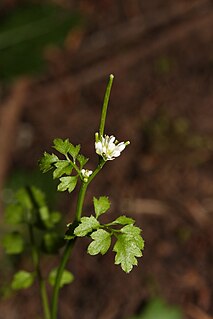
Brassicaceae or Cruciferae is a medium-sized and economically important family of flowering plants commonly known as the mustards, the crucifers, or the cabbage family. Most are herbaceous plants, some shrubs, with simple, although sometimes deeply incised, alternatingly set leaves without stipules or in leaf rosettes, with terminal inflorescences without bracts, containing flowers with four free sepals, four free alternating petals, two short and four longer free stamens, and a fruit with seeds in rows, divided by a thin wall.

Cardamine is a large genus of flowering plants in the mustard family, Brassicaceae, known as bittercresses and toothworts. It contains more than 200 species of annuals and perennials. Species in this genus can be found worldwide, except the Antarctic, in diverse habitats. The name Cardamine is derived from the Greek kardaminē, water cress, from kardamon, pepper grass.

Alyssum is a genus of about 100–170 species of flowering plants in the family Brassicaceae, native to Europe, Asia, and northern Africa, with the highest species diversity in the Mediterranean region. The genus comprises annual and perennial herbaceous plants or (rarely) small shrubs, growing to 10–100 cm tall, with oblong-oval leaves. Alyssum flowers are characteristically small and grouped in terminal clusters; they are often yellow or white colored but can be pink or purple.

Alyssoides is a genus of flowering plants in the family Brassicaceae containing a single species, Alyssoides utriculata. A herbaceous perennial plant native to Southern Europe and Turkey, it grows on dry rocky slopes and on calcareous rocks, reaching heights of 20 to 50 cm and blooming with yellow flowers between April and May–July.

Heliophila is a genus of flowering plants in the family Brassicaceae. Members of this genus are either annuals or perennials and some are popular as ornamental plants. Endemic to southern Africa, the majority of the approximately 80 species grow in South Africa, particularly the Cape Floristic Region, while a few extend into the Namib Desert.

Peltaria is a genus of flowering plants in the family Brassicaceae. Their distribution ranges from Southeast Europe, Near East to Central Asia. They prefer rocky slopes.
Ihsan Ali Al-Shehbaz, Ph.D. is an Iraqi American botanist who works as Adjunct Professor at University of Missouri-St. Louis and Senior Curator at Missouri Botanical Garden. Al-Shehbaz's primary area of interest is Brassicaceae and The Durango Herald called him "a world expert on taxonomy of the family". A 2008 publication of the United States Fish and Wildlife Service called him "the world's authority on species in the genus Lesquerella". The author abbreviation "Al-Shehbaz" is attached to the numerous botanical taxa he has identified.
Coincya cintrana is a flowering plant of the family Brassicaceae. It is a hemicryptophyte plant, and it grows on walls, in steep areas and in rocky slopes. It flowers from April until June.
Cardamine gouldii is a plant species endemic to Bhutan. It is known only from a single specimen in the herbarium of Kew Botanic Garden in London, collected in 1938 in the Bumthang District.
Boechera tularensis, common name Tulare rockcress, is a plant species endemic to California. It has been reported from Inyo, Mono, Tulare, Fresno, Madera, El Dorado and Mariposa Counties. It grows on rocky slopes in subalpine habitats at elevations of 2400–3200 m.
Odontarrhena troodi is a 10–25 cm high perennial subshrub. Leaves 5–10 mm long obovate-spatulate, covered with a silvery indumentum. Flowering and sterile shoots on the same plant, On the sterile shots the leaves form terminal clusters. Flowers have 3 mm long golden-yellow petals. The siliques are 7–8 mm long, elliptic and glabrous. Flowers from May to July.

Selenia aurea, the golden selenia, is a flowering plant in the mustard family (Brassicaceae). It is endemic to the southern United States where it grows in sunny prairies, barrens, and glades of Arkansas, Kansas, Missouri, and Oklahoma. It flowers between March and May.
Zuloagocardamum jujuyensis is a very rare, dwarf species of caudiciform cress-like plant in the family Brassicaceae which was first described in 2014. It is endemic to mountains in Jujuy Province in northern Argentina, where it is only known to grow on the grounds of El Aguilar mine at 3,700 meters in altitude. It is only known from a single recent collection. It is the only species in the new genus Zuloagocardamum, a monotypic genus. It is quite similar in fruit and flower to Chilocardamum and Weberbauera, but the taxonomists describing the species decided it was sufficiently distinguished by dint of its well-developed, woody caudex, and extremely reduced, leafless branches bearing small rosulate tufts of linear leaves, and sticky, mucilaginous seeds.
Chilocardamum is a small genus of four herbaceous cress-like species of plants in the family Brassicaceae, only found growing in Patagonia, southern Argentina.

Polypsecadium is a genus of large herbaceous species of plants in the family Brassicaceae, found growing in South America. Most of the species were formerly classified in the genus Sisymbrium.

Physaria ludoviciana is a species of flowering plant in the mustard family Brassicaceae, with the common names of bladder pod, silver bladderpod, louisiana bladderpod, and foothill bladderpod. It used to be Lesquerella ludoviciana which is now a synonym.

Alyssum montanum is a species of flowering plant belonging to the family Brassicaceae. It is an evergreen, prostrate perennial with small, hairy, greyish leaves. It typically grows to 10-15 centimeters tall and 30-45 centimeters across. It produces tiny, yellow, fragrant flowers from May to July. These flowers are typically 4-6 centimeters across and borne in dense racemes.
Resetnikia is a genus of flowering plants belonging to the family Brassicaceae.
Parlatoria is a monotypic genus of flowering plants belonging to the family Brassicaceae. It just contains one species, Parlatoria cakiloideaBoiss.

Odontarrhena is a large genus of flowering plants in the family Brassicaceae. They were originally a separate genus and then were amalgamated into the Alyssum genus, but then morphological and molecular evidence has reseperated them. Some of the genera are nickel (Ni) hyperaccumulators.












